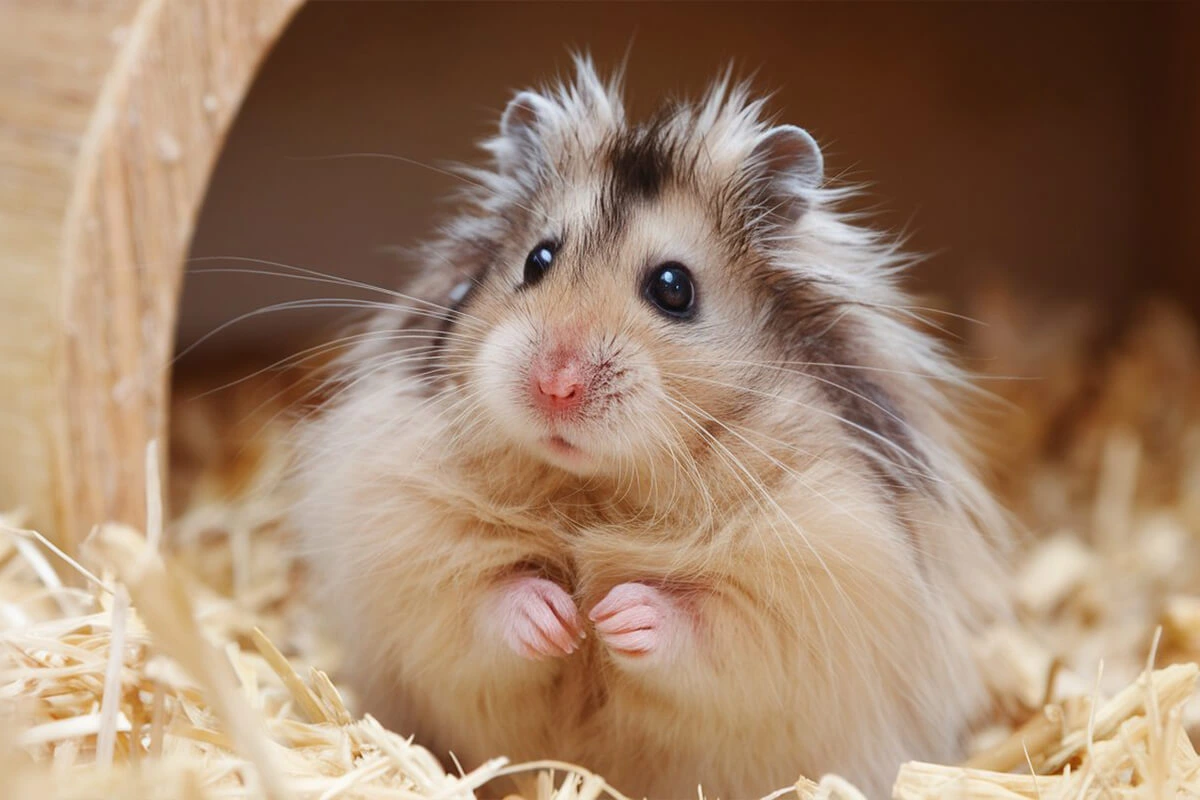The Long-Haired Syrian Hamster stands out as one of the fluffiest and most adorable small pets. This tiny rodent, often called the “Teddy Bear Hamster,” has a soft, flowing coat that gives it a unique and charming appearance. Pet owners love these hamsters for their friendly nature, making them a great choice for both beginners and experienced hamster enthusiasts. Unlike some other hamster species, Syrian hamsters prefer living alone, which makes them easy to care for without worrying about compatibility with other pets.
These hamsters have curious and playful personalities, often entertaining their owners with their energetic antics. They love to burrow, explore their surroundings, and run on their exercise wheels for hours. Since they are nocturnal, they become most active in the evening and at night. Anyone considering a Long-Haired Syrian Hamster as a pet should understand its basic care needs, from proper grooming to a well-balanced diet and a spacious cage setup. In this blog, you will discover ten amazing facts about these fluffy companions, helping you understand why they make such wonderful pets.
Introduction to the Long-Haired Syrian Hamster
Overview of the Breed and Its Fluffy Coat
The Long-Haired Syrian Hamster is a special variety of the Syrian hamster species, known for its luxurious, flowing fur. Male long-haired Syrians tend to have longer coats that can grow into a soft, skirt-like fringe, while females typically have shorter, fluffier fur. This long fur gives them an irresistibly cuddly appearance, making them a favorite among hamster lovers. Their coats require occasional grooming to prevent tangles and matting, especially for males with extra-long fur. Regular brushing with a soft toothbrush or a small pet comb helps keep their fur smooth and clean. Unlike some other rodents, Syrian hamsters groom themselves frequently, but their long fur benefits from a little extra care.
These hamsters come in various colors and patterns, including golden, cream, cinnamon, sable, and even rare shades like silver or lilac. Their round, chubby bodies, tiny paws, and shiny black eyes make them look like miniature stuffed animals. Because of their unique fur and variety of colors, Long-Haired Syrian Hamsters often attract attention in pet stores and are a popular choice for first-time hamster owners.
Why The Long-Haired Syrian Hamster Makes Great Pet
Long-Haired Syrian Hamsters make wonderful pets for people of all ages, especially those looking for a low-maintenance, independent companion. Unlike some other small animals, these hamsters do not require constant social interaction, but they still enjoy bonding with their owners. With gentle handling and patience, they can become quite tame and even learn to recognize their human caregivers. Some hamsters may even come to the front of their cage when they hear their owner’s voice or the sound of food being prepared.
Since Syrian hamsters prefer to live alone, there’s no need to worry about fights or territorial disputes with other hamsters. This makes them easier to care for compared to dwarf hamster species that require careful introductions and monitoring when housed together. Their relatively simple diet, consisting of high-quality hamster food, fresh vegetables, and occasional treats, makes feeding them straightforward.
Additionally, these hamsters do not require large enclosures like rabbits or guinea pigs, making them perfect for people with limited space. As long as they have a well-ventilated cage with plenty of bedding, an exercise wheel, and chew toys, they will stay happy and healthy.
General Temperament and Behavior
Long-Haired Syrian Hamsters have curious and playful personalities. They love to explore their environment, dig in their bedding, and create intricate tunnel systems inside their cages. Since they are nocturnal, they spend most of the day sleeping and become active in the evening. Owners often notice their hamsters running on their exercise wheels, climbing on cage accessories, or chewing on toys to keep their teeth healthy.
These hamsters can be a little shy at first, but they usually warm up to gentle handling over time. They respond well to positive reinforcement, such as offering treats to encourage trust. Unlike some smaller hamster species that tend to be more skittish, Syrian hamsters generally tolerate handling better, making them ideal for children or first-time pet owners.
While they enjoy human interaction, they also appreciate their independence. They do not need constant attention and can entertain themselves with their toys and activities. However, handling them regularly helps maintain their social nature and prevents them from becoming too timid. Since they have strong instincts for burrowing and hoarding food, owners often find little food stashes hidden in corners of the cage or inside tunnels.
Overall, Long-Haired Syrian Hamsters bring joy and entertainment with their charming behavior, soft coats, and friendly personalities. Understanding their needs and habits allows owners to build a strong bond with these adorable pets while ensuring they stay happy and healthy.
Essential Care for The Long-Haired Syrian Hamster
Syrian Hamster Care
Caring for a Long-Haired Syrian Hamster requires attention to their habitat, diet, grooming, and overall well-being. These hamsters thrive in a clean, spacious, and enriching environment. Since they live alone, they rely on their owners for social interaction and stimulation. Spending time with your hamster daily helps them stay tame and comfortable around people.
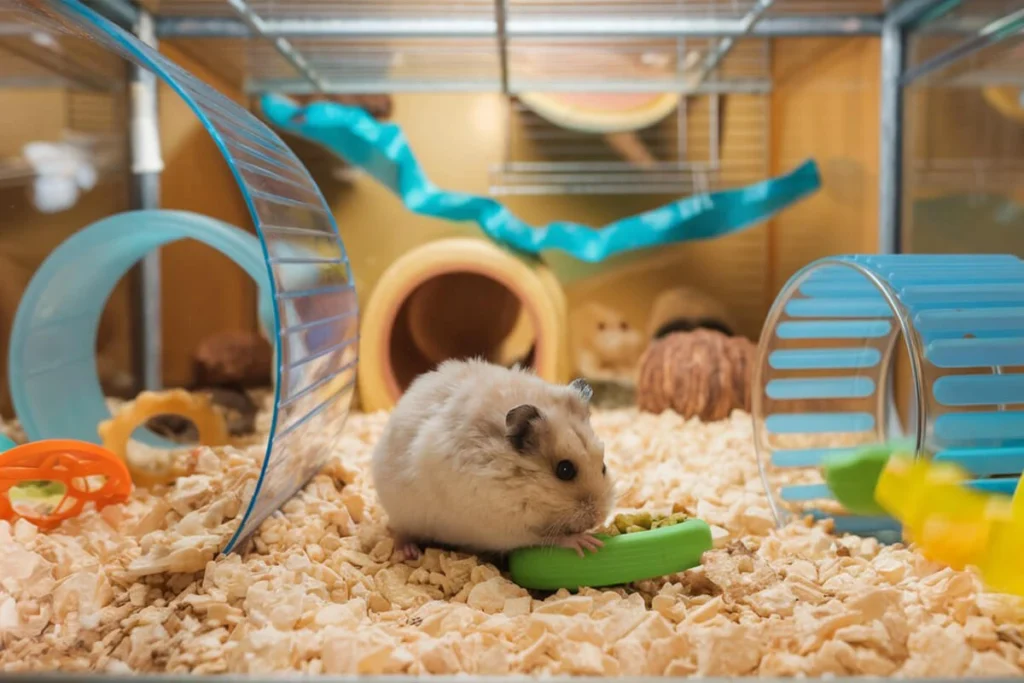
Providing a balanced diet ensures they stay healthy and energetic. Offer high-quality hamster pellets or seed mixes as their primary food source. Fresh vegetables like carrots, cucumbers, and leafy greens add important nutrients to their diet, while occasional treats like small pieces of fruit or mealworms provide variety. Always ensure fresh, clean water is available in a bottle with a sipper tube.
Since long-haired Syrians have fluffy coats, regular grooming prevents tangles and keeps their fur clean. A soft toothbrush or a small pet comb helps remove debris from their fur. Avoid bathing them with water, as hamsters naturally groom themselves and rely on sand baths to remove excess oils from their coats. Providing a small dish of chinchilla sand allows them to maintain proper fur hygiene.
Best Cage for Syrian Hamsters
Choosing the right cage plays a crucial role in your hamster’s happiness and health. Syrian hamsters need a spacious cage to accommodate their natural instincts to explore, burrow, and exercise. A minimum cage size of 450 square inches of floor space is ideal, but larger enclosures provide even more enrichment.
You can choose between glass tanks, wire cages, or DIY bin cages. Glass tanks with secure mesh lids offer excellent visibility and prevent escapes, while wire cages provide better ventilation. Bin cages, made from large plastic storage containers with ventilation holes, offer an affordable and customizable housing option.
Ensure the cage includes deep bedding for burrowing, an appropriately sized exercise wheel, and plenty of toys to keep them entertained. Avoid cages with tubes or small compartments designed for dwarf hamsters, as Syrian hamsters are larger and can get stuck in tight spaces.
Bedding Choices
Providing the right bedding ensures comfort, absorbs moisture, and allows hamsters to burrow. Choose soft, dust-free, and absorbent bedding to create a cozy environment.
- Paper-based bedding: Safe, absorbent, and great for burrowing. Popular brands like Carefresh or Kaytee Clean & Cozy work well.
- Aspen shavings: A natural wood-based bedding option that is safe for hamsters and provides a pleasant scent.
- Coconut husk fiber: An eco-friendly and natural alternative that mimics the soft ground in the wild.
Avoid cedar and pine shavings, as their strong scents and oils can cause respiratory issues. Keep bedding at least 4 to 6 inches deep to allow for natural burrowing behaviors. Spot-clean daily and replace all bedding every two to three weeks to maintain cleanliness.
Exercise Wheel & Chew Toys
A well-exercised hamster stays healthy and happy. Syrian hamsters need an exercise wheel to burn off energy and prevent obesity. Choose a wheel that is at least 10 to 12 inches in diameter to prevent back strain. Solid-surface wheels work best because wire wheels can cause injuries if a hamster’s tiny feet slip through the gaps. Popular options include silent running wheels that reduce noise while your hamster runs at night.
Chew toys play an essential role in dental health. Hamsters’ teeth grow continuously, so they need safe materials to chew on. Offer a variety of chew toys, such as:
- Wooden blocks or sticks (from hamster-safe woods like apple or willow)
- Pumice stones
- Compressed hay cubes
- Cardboard tubes (like toilet paper rolls for additional play enrichment)
Providing different textures encourages natural chewing instincts and prevents overgrown teeth. Rotating toys regularly keeps them engaged and prevents boredom.
By setting up a proper living space, offering safe bedding, and including enrichment like wheels and chew toys, you can create a comfortable and stimulating home for your Long-Haired Syrian Hamster.
Grooming and Maintenance Tips For The Long-Haired Syrian Hamster
Hamster Grooming Tips
Grooming a Long-Haired Syrian Hamster keeps their fur clean, soft, and free from tangles. These fluffy hamsters groom themselves frequently, but their long coats require extra attention to prevent matting. Brushing their fur a few times a week helps remove dirt and loose hair. Use a soft toothbrush, a small pet comb, or a flea comb to gently brush through their fur. Always brush in the direction of hair growth to avoid pulling or causing discomfort.
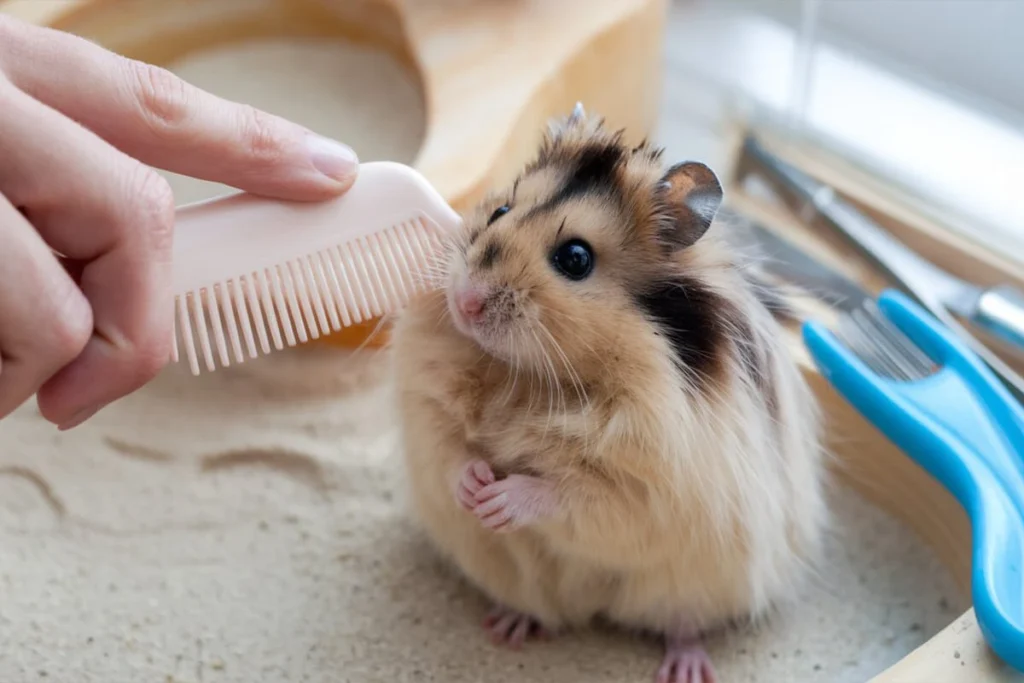
Providing a sand bath helps your hamster maintain proper fur hygiene. Unlike water baths, which can cause stress and remove essential oils from their skin, a sand bath allows them to naturally clean themselves. Place a shallow dish filled with chinchilla sand (not dust) inside the cage a few times a week. Your hamster will roll around in the sand, which absorbs excess oils and removes dirt from their fur.
Check their fur regularly for bedding or food particles stuck in their coat. If their fur looks greasy or tangled, increase the frequency of sand baths and gentle brushing. Avoid using scissors unless absolutely necessary, as sudden movements may startle them. Instead, gently work out knots with your fingers or a pet-safe detangling spray if needed.
Fluffy Hamster Breeds
The Long-Haired Syrian Hamster is one of the fluffiest hamster breeds, but other breeds also have unique coat types. Knowing these variations helps you understand their grooming needs.
- Teddy Bear Hamster (Long-Haired Syrian Hamster): Males have long, flowing coats, while females have shorter but still fluffy fur. Regular grooming is essential for males.
- Rex Syrian Hamster: This variation has a wavy or curly coat, giving them a unique, textured appearance. Their fur feels soft but can become slightly coarse as they age.
- Angora Hamster: Sometimes used to describe long-haired Syrians with extra-long fur, Angora hamsters need frequent brushing to prevent matting.
- Satin Syrian Hamster: This variety has a sleek, shiny coat that appears glossier than normal fur. Their fur feels smoother but doesn’t require extra grooming like long-haired types.
Long-haired hamsters require more grooming than short-haired varieties, but all Syrian hamsters benefit from occasional fur checks and sand baths to stay clean.
Preventing Matting & Tangles
Preventing matting and tangles keeps your hamster comfortable and healthy. Without regular care, long-haired hamsters develop knots in their fur, which can trap dirt and cause discomfort.
- Brush their fur at least twice a week to remove loose hair and prevent knots from forming.
- Use soft bedding materials like paper-based bedding instead of wood shavings, which can tangle in long fur.
- Avoid sticky or wet foods near their fur. Instead of juicy fruits, offer dried fruit or small veggie pieces to prevent food from getting stuck in their coat.
- Check their fur daily for signs of tangles, bedding stuck in their coat, or damp spots from water bottles or food dishes.
If you notice a small mat, gently separate the fur using your fingers or a comb. If a tangle becomes severe, you may need to carefully trim the affected area with rounded-tip pet scissors. Always hold your hamster securely to prevent sudden movements that could lead to accidental cuts.
Nail & Teeth Care
Keeping a hamster’s nails and teeth healthy prevents discomfort and health issues. Since hamsters constantly use their teeth and nails for daily activities, they need natural ways to keep them trimmed.
- Teeth: A hamster’s teeth grow continuously, so they need safe materials to chew on. Offer wooden chew toys, pumice stones, hay cubes, or untreated cardboard to help wear down their teeth naturally. Overgrown teeth can make eating difficult and may require veterinary trimming. If your hamster drools, refuses food, or struggles to chew, check their teeth for signs of overgrowth.
- Nails: In the wild, hamsters wear down their nails by digging and climbing. Pet hamsters may need occasional nail trims if their nails grow too long. If you notice curved or overly sharp nails, use small pet nail clippers to trim the tips carefully. Provide rough-textured surfaces like stone tiles or wooden platforms in their cage to help wear down nails naturally.
By following these grooming tips, you ensure your Long-Haired Syrian Hamster stays clean, comfortable, and healthy while maintaining their soft and fluffy coat.
Diet and Health Tips for a Happy Hamster
Hamster Diet and Nutrition
Feeding a Long-Haired Syrian Hamster a balanced diet ensures they stay healthy, active, and full of energy. In the wild, Syrian hamsters eat a variety of seeds, grains, insects, and vegetables. Replicating this diverse diet at home helps meet their nutritional needs.
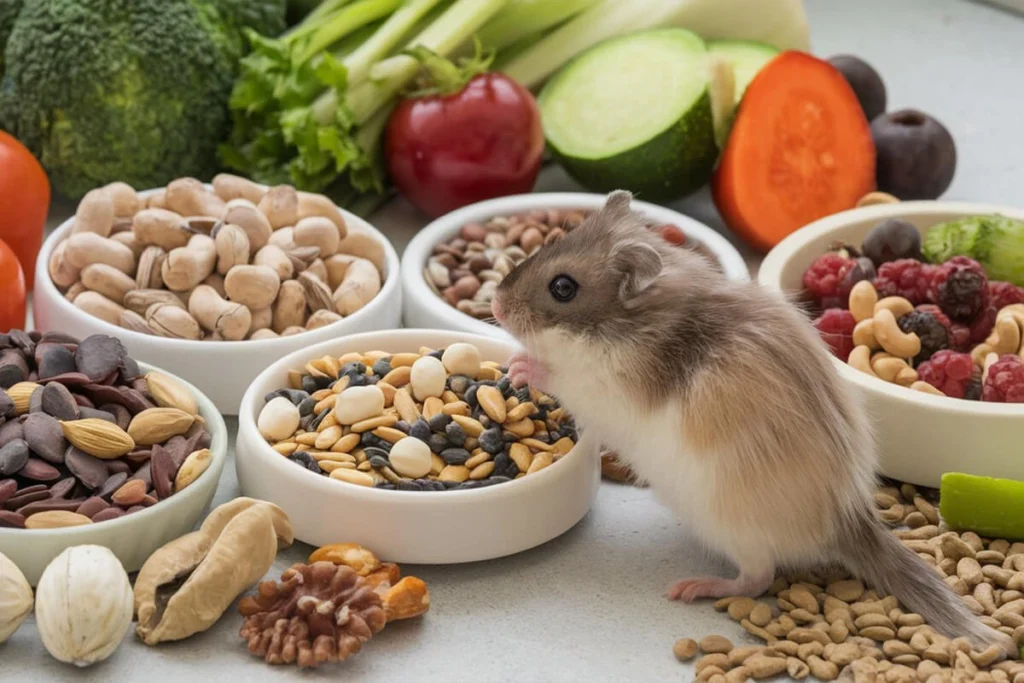
The primary food source should be high-quality hamster pellets or seed mixes. Pellets provide a well-balanced diet with all the necessary vitamins and minerals, while seed mixes encourage natural foraging behavior. However, some hamsters tend to pick out their favorite seeds and ignore the rest, so offering pellets alongside seeds prevents nutritional deficiencies.
Fresh vegetables add important nutrients and fiber to their diet. Safe vegetables include:
- Carrots (rich in vitamin A but should be given in moderation due to natural sugars)
- Cucumbers (great for hydration)
- Broccoli and spinach (packed with vitamins)
- Bell peppers (full of vitamin C)
Fruits should be given in small amounts since they contain natural sugars. Safe fruits include:
- Apples (without seeds)
- Bananas
- Blueberries
- Strawberries
Avoid feeding hamsters citrus fruits (oranges, lemons), onions, garlic, or processed foods, as these can cause digestive issues. Providing a varied diet keeps their meals interesting while ensuring they receive essential nutrients.
Hydration & Treats
Proper hydration plays a crucial role in keeping your hamster healthy. Always provide fresh, clean water in a water bottle with a sipper tube. Check the bottle daily to ensure it isn’t clogged or leaking. Some hamsters also drink from shallow water dishes, but water bottles remain the best option to prevent spills.
Hamsters love treats, but moderation is key. Healthy treat options include:
- Pumpkin seeds and sunflower seeds (great for protein and healthy fats)
- Dried mealworms (a good protein source)
- Unsalted nuts (like almonds or walnuts) (small portions only)
- Plain oats or whole-grain cereals (without added sugar)
Store-bought hamster treats can also be given occasionally, but avoid those with artificial flavors, colors, or excess sugar. Offering treats by hand helps build trust and strengthens the bond between you and your hamster.
Hamster Health Tips
Keeping a Long-Haired Syrian Hamster healthy requires a combination of proper diet, hygiene, and regular monitoring. Since hamsters are small and naturally hide signs of illness, daily observation helps detect any health concerns early.
Follow these essential health tips:
- Provide a clean cage by spot-cleaning daily and fully cleaning it every two to three weeks. A dirty environment can cause respiratory and skin infections.
- Check their fur, eyes, and ears daily for any signs of discharge, bald spots, or irritation. Healthy hamsters have bright eyes, clean ears, and well-groomed fur.
- Monitor their weight and eating habits. A sudden loss of appetite or weight loss may indicate an underlying health problem.
- Make sure they get enough exercise. A hamster that stops using its wheel or becomes lethargic may need a vet check-up.
Regularly handling your hamster allows you to notice any physical or behavioral changes early. A healthy hamster remains active, alert, and curious about its surroundings.
Common Health Issues
Even with proper care, hamsters can develop health problems. Knowing the symptoms of common illnesses helps owners take quick action.
- Wet Tail (Diarrhea and Lethargy)
- One of the most serious hamster illnesses, wet tail causes severe diarrhea, dehydration, and weakness. Stress, poor hygiene, or an improper diet can trigger it. If you notice a wet or soiled tail area, take your hamster to a vet immediately.
- Respiratory Infections
- Hamsters can develop colds and respiratory infections if exposed to drafts, dusty bedding, or poor ventilation. Symptoms include sneezing, wheezing, or nasal discharge. Keeping their cage in a warm, dry area prevents respiratory issues.
- Overgrown Teeth
- Hamster teeth never stop growing, so they must chew regularly to wear them down. Without proper chew toys, teeth can become overgrown, making it difficult to eat. Provide wooden chew toys, hay cubes, or safe cardboard materials to keep their teeth trimmed naturally.
- Skin Problems and Fur Loss
- Long-haired hamsters can experience matted fur, bald patches, or dry skin if their grooming needs aren’t met. Mites, fungal infections, or nutritional deficiencies may also cause fur loss. Regular grooming and a proper diet prevent most skin-related issues.
- Obesity and Diabetes
- Syrian hamsters are prone to obesity if they don’t get enough exercise or eat too many fatty treats. A balanced diet, a large running wheel, and daily playtime outside the cage help maintain a healthy weight. Avoid sugary foods to reduce the risk of diabetes, especially in older hamsters.
By providing a nutritious diet, proper hydration, and regular health checks, you can help your Long-Haired Syrian Hamster live a long, happy, and healthy life.
Fun Facts About Long-Haired Syrian Hamster Behavior
Pet Hamster Behavior
Understanding the behavior of a Long-Haired Syrian Hamster helps you create a better bond with your pet while ensuring they feel comfortable and safe. Syrian hamsters have distinct personalities, and their behavior reflects their natural instincts. They love to explore, burrow, hoard food, and engage in playful activities when given a proper environment.
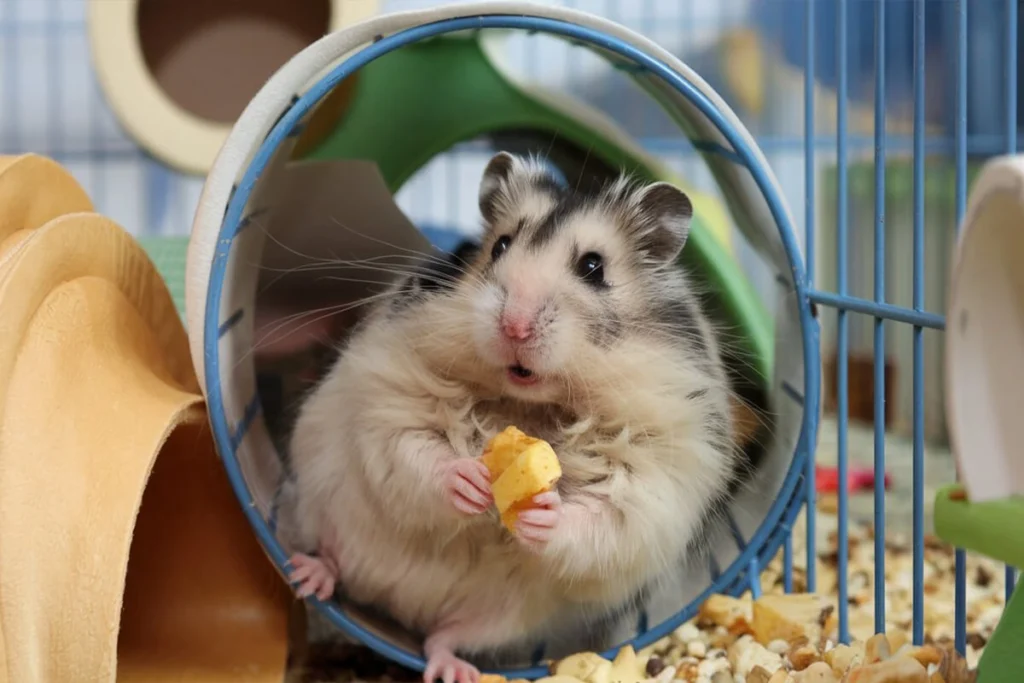
Since they are naturally curious, they will often investigate new toys, tunnels, and hideouts in their cage. You might notice your hamster stuffing their cheek pouches with food or bedding—this is an instinct they developed in the wild to transport food back to their burrows. Providing tunnels and deep bedding allows them to exhibit this natural behavior.
Some Syrian hamsters enjoy being handled, while others prefer more independence. If you start taming them early, they become more social and comfortable with human interaction. However, each hamster has a unique personality—some are energetic and playful, while others are more cautious and reserved.
By observing their daily habits, you can learn their preferences and build trust. Hamsters communicate through body language, squeaks, and even subtle movements. A relaxed hamster may stretch out, groom themselves, or explore freely, while a frightened or stressed hamster might freeze, flatten their ears, or hide. Learning to recognize these signs helps you interact with them in a way that keeps them comfortable.
Long-Haired Syrian Hamster Nocturnal Nature
Syrian hamsters are nocturnal, meaning they sleep during the day and become active at night. In the wild, this behavior helps them avoid predators while searching for food in the cool nighttime hours. As a pet, this means they will spend most of the day sleeping and wake up in the evening, ready to explore and play.
If you try to wake your hamster during the day, they may appear grumpy, disoriented, or even defensive. Waking them too often can lead to stress, so it’s best to interact with them in the evening when they are naturally awake. You might notice them stretching, yawning, and grooming themselves as they wake up—these are signs they’re getting ready for their active hours.
Since hamsters stay active at night, their exercise wheel, chew toys, and tunnels become essential for their mental and physical stimulation. If you keep their cage in your bedroom, consider getting a silent exercise wheel to minimize noise while they run at night.
Although they are nocturnal, some hamsters may adjust slightly to their owner’s schedule. If you interact with them gently in the early evening, they may start waking up a little earlier to spend time with you.
Is The Long-Haired Syrian Hamster Social or Solitary?
Syrian hamsters are strictly solitary animals and should never be housed with another hamster. In the wild, they only interact with other hamsters during breeding, and once they mature, they prefer to live alone. Unlike dwarf hamsters, which can sometimes live in pairs, Syrian hamsters become aggressive when kept together.
If two Syrian hamsters share the same cage, they will eventually fight, often leading to severe injuries or even death. Pet stores sometimes house young Syrian hamsters together, but as they grow, they must be separated to avoid conflict.
Although they do not need cage mates, they can form strong bonds with their human owners. Regular handling and playtime help them feel secure and comfortable around people. Some hamsters even recognize their owners’ scent and voice, showing excitement when they approach the cage.
If you want multiple hamsters, house them in separate enclosures and allow them to explore individually during supervised playtime. Each hamster needs its own space, toys, and hideouts to feel safe and stress-free.
Surprising Intelligence
Despite their small size, Long-Haired Syrian Hamsters are highly intelligent and can learn routines, recognize their owners, and even respond to training. Their natural problem-solving abilities allow them to navigate mazes, find hidden treats, and adapt to new environments.
Some hamsters learn to associate certain sounds or actions with food. If you tap their food dish before feeding them, they may start coming to the dish when they hear the sound. Similarly, they recognize their owners by scent and voice, often becoming more active when they hear familiar voices nearby.
Hamsters can also learn simple tricks, such as standing on their hind legs, jumping through small hoops, or coming to their owner’s hand. Positive reinforcement with treats encourages learning and builds trust.
Their intelligence also shows in how they organize their cage space. Many hamsters create distinct areas for sleeping, storing food, and using the bathroom. Some even prefer a specific spot in their cage for burrowing or building nests. Observing these behaviors helps you understand their unique personality and make their environment more enriching.
By respecting their nocturnal schedule, recognizing their solitary nature, and engaging with their intelligence, you can form a rewarding and enjoyable bond with your Long-Haired Syrian Hamster.
Conclusion
Owning a Long-Haired Syrian Hamster is a rewarding experience, especially when you understand their unique needs and behaviors. These fluffy, independent pets thrive when provided with the right diet, a well-maintained habitat, and plenty of enrichment. Their nocturnal nature means they are most active in the evenings, making them great companions for owners who enjoy interacting with them after a long day.
Proper care includes regular grooming, a balanced diet, and a spacious cage with safe bedding and essential accessories. Since their long fur requires extra attention, brushing them a few times a week prevents matting and tangles. Providing a sand bath, chew toys, and a sturdy exercise wheel ensures they stay healthy and entertained. Their solitary nature means they should never share a cage with another hamster, but they can still form strong bonds with their human owners through gentle handling and playtime.
Despite their small size, Syrian hamsters are intelligent and curious creatures. They recognize their owners, learn routines, and enjoy solving simple puzzles. Observing their behaviors, from food hoarding to burrowing and exploring, makes hamster ownership both entertaining and fascinating.
By meeting their needs and respecting their natural instincts, you can help your Long-Haired Syrian Hamster live a long, happy, and healthy life. Whether you are a first-time hamster owner or an experienced pet parent, understanding these adorable rodents allows you to provide them with the best care possible. With patience and attention, your fluffy companion will thrive and bring joy to your home.
Read More About The Syrian Hamster Breed Here.
What are The 5 Best Syrian Hamster Colors? Find Out Here
Choose The Best Name For your Lovely Hamster from our Top 100 Names HERE!
Read More about other Furry Pets From HERE!
Find Good stuff for your Tiny Pets On Pet MD Official
